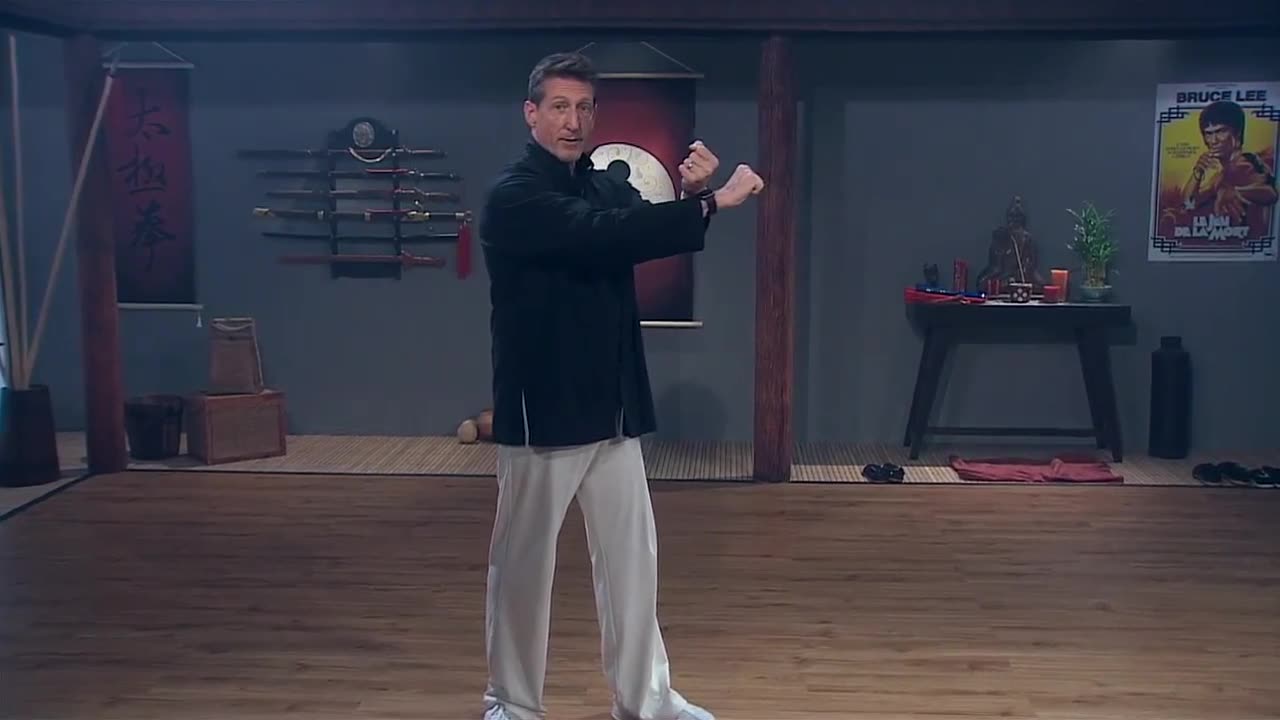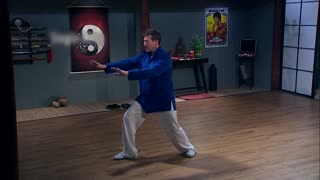Premium Only Content

22. Lotus Kick And Laughing Buddha
This lecture gets us even deeper into our 40-movement routine by
introducing two new moves: step back to ride the tiger and the lotus kick.
These are the 34th and 35th moves, so we’re getting near the end. We’ll
close the lecture with how tai chi can serve as a form of self-development,
and we’ll come to a surprising revelation: Perfection is not the goal.
Tuì bù kuà hǔ (“Step Back to Ride Tiger”)
● The first movement we’re going to learn in this lecture is called tuì
bù kuà hǔ, which in English means “step back to ride tiger.”
● From the end of the seven stars posture, step back with the right
foot to create an empty step on the left side. Turn the waist to the
right and sweep both hands down to the sides past the hips. Open
the palms.
● Turn the waist back to the left, and settle down in the empty step,
with all the weight on the right foot. As you turn back to the left
(facing east), flash the right palm overhead, in front of the forehead
with the palm facing out.
Zhuǎn shēn bǎi lián (“Turn and Lotus Kick”)
● The next move on our list is called zhuǎn shēn bǎi lián, which in
English means “turn and lotus kick.” Imagine you’re taking a lotus
flower, placing it in a vase, and displaying it for everybody to see
how beautiful it is.
● Lift the right foot and swing it leftward, upward and rightward with
the instep facing rightward. At the same time, with the torso turning
slightly to the right and then to the left, use both hands to pat the
foot. (The left palm hits first, then the right palm.)
Tai Chi and Self-Development
● When you practice tai chi, the first movement is the
commencement. You get started. Then you take the first step, and
you keep trying to connect everything with breath that is deep,
lengthy, and continuous.
● If you let yourself play, after a moment, you’ll stop worrying. Your
mind will clear, and you’ll find tranquility that resides inside of
motion, and hopefully you’ll also make a discovery that this is a way
that you could live your entire life. That’s the message of tai chi.
● The path of mastering tai chi is actually the path of selfdevelopment, but the direction of our development is not outward. The direction is not to become something or someone different
than who we are. It’s actually an inward journey, to rediscover who
we were born to be, because maybe have hidden ourselves from
ourselves all along.
● This path, in the classic Chinese text Dao De Jing and elsewhere,
is called the path of returning to the state of the uncarved block.
The word that we have for this is authenticity.
● When you meditate on the path to mastery of tai chi, be careful
to remember that mastery does not mean perfection. Mastery is
a process that just keeps going on eternally, while perfection is
the final achievement of the ideal. Perfection is like the final full
blossoming of the lotus flower.
● But that moment of perfect blossoming is also the start of the
decline towards death and decay. In tai chi, the masters never
talk about perfecting the movements. You always want to be in the
state just before that, still blossoming, still growing, still learning,
and still changing.
-
 32:54
32:54
Mastering Tai Chi
1 year ago23. Conserve Your Energy
889 -
 LIVE
LIVE
NEWSMAX
5 months agoNEWSMAX2 LIVE | Real News for Real People
2,791 watching -
 13:05
13:05
Actual Justice Warrior
3 days agoJudge Threatens To Jail Corrupt Super Mayor
13.4K22 -
 3:40
3:40
DecoyVoice
1 year agoThailand doesn't have time for unemployed behavior
29.8K19 -
 11:09
11:09
Warren Smith - Secret Scholar Society
8 months agoThis Interview Changed How I See the World
38.5K13 -
 2:05:07
2:05:07
Inverted World Live
7 hours agoDemon Dolls and Doomsday Fish | Ep. 52
94.7K6 -
 1:31:12
1:31:12
"What Is Money?" Show
1 day agoBuy Bitcoin for Your Bloodline w/ Robert Breedlove (WiM589)
35.3K1 -
 6:50
6:50
Dr. Nick Zyrowski
22 days agoApple Cider Vinegar Fasting Drink - Fasting Accelerator
32.8K4 -
 1:07:48
1:07:48
Man in America
6 hours ago🚨 Plandemic 2.0: The July 4th Bioterror Plot & Palantir’s Master Plan w/ Dr. David Martin
58K42 -
 1:43:07
1:43:07
Tucker Carlson
1 day agoBishop Barron on the New Pope, the Foolishness of Atheism, and Why Young Men Are Turning to Christ
223K209